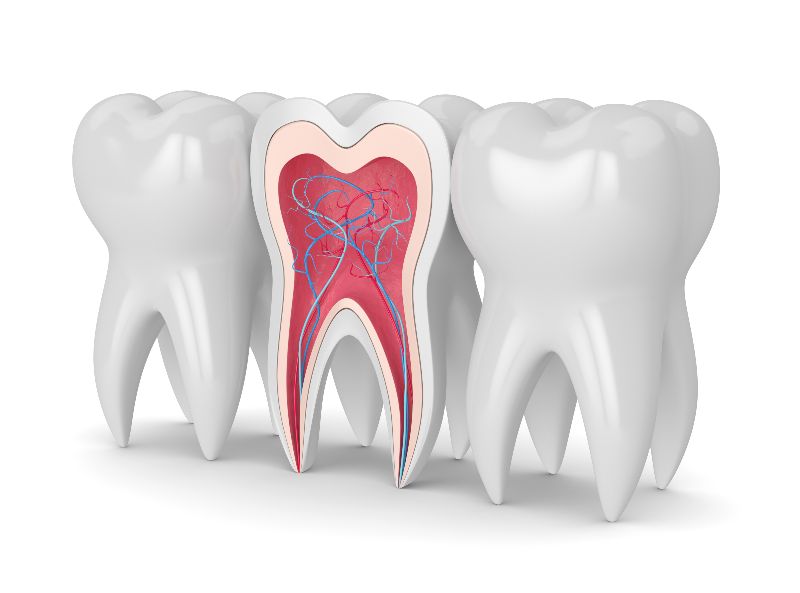When persistent tooth pain strikes, it often signals something more serious than a temporary sensitivity, which is when restorative dentistry procedures like root canal therapy become essential. Root canal therapy—a procedure that relieves pain rather than causes it—has evolved dramatically from its fearsome reputation. Modern techniques have transformed this treatment into a comfortable experience comparable to getting a filling, providing immediate relief while saving your natural tooth from extraction.
At JAX Dental Studio, Dr. Charles Poblenz and his team provide gentle, effective root canal treatments to eliminate infection and preserve your natural teeth. Using advanced techniques and offering comfort options including local anesthesia and sedation, they ensure the procedure is as comfortable as possible while delivering lasting results. If you’re experiencing tooth pain, their experienced team is ready to help restore your comfort and smile.

During your appointment, your dentist will perform an exam and review your x-rays in order to properly diagnose your issue. If it is a tooth infection, the next step is to determine the extent of the infection, and decide whether or not root canal therapy will be effective for treating the problem.
To start the procedure, your dentist will numb the site, including the nerves of the treatment area, using a numbing needle. You may also opt to receive sedation to ensure you feel comfortable throughout the process.
Once you are comfortably numb, your dentist will begin removing any decayed material starting with the enamel. From there, they will move toward the pulp. Once the infected pulp is removed from the inside of the tooth and the canals have been thoroughly cleaned, the area is flushed with disinfectant to eliminate bacteria.
After the inside of the tooth has been cleaned and sanitized, the root canals will be filled with a rubber-like material called “gutta-percha.” This inert substance replaces the extracted pulp and supports the interior of the tooth to maintain structure.
Once the interior of the tooth has been filled, it will be restored with either a filling or a dental crown, depending on how much enamel was lost during the procedure.
Comprehensive dental care accessible to all families regardless of insurance type or coverage limitations.

Root canal infections occur when bacteria penetrate the protective outer layers of your tooth and reach the dental pulp—the soft tissue inside containing nerves, blood vessels, and connective tissue. This invasion typically happens through deep cavities, cracks in the tooth, or traumatic injuries that compromise the tooth’s integrity. As bacteria multiply within this once-sterile environment, an infection develops, causing inflammation and significant pain.
The most telltale sign of a root canal infection is persistent, throbbing tooth pain that may intensify when pressure is applied or when consuming hot or cold foods and beverages. You might also experience swelling around the affected tooth, prolonged sensitivity, discoloration of the tooth, or tender lymph nodes. Some patients even develop a small pimple-like bump on the gums near the infected tooth—a dental abscess, indicating that infection has spread beyond the tooth root.
Left untreated, these infections don’t resolve on their own and can lead to serious complications. The infection may spread to surrounding tissues, creating larger abscesses that can affect neighboring teeth. In severe cases, the infection can enter the bloodstream, potentially leading to systemic health issues. This is why prompt treatment through root canal therapy is essential not just for relieving pain but also for protecting overall health.
Most patients are surprised by how quickly they recover after root canal therapy. While you may experience mild discomfort for a few days following the procedure, this can typically be managed with over-the-counter pain relievers. Your dentist may recommend avoiding chewing on the treated tooth until your permanent restoration is placed to prevent potential fractures in the temporarily sealed tooth.
Post-treatment care tips:
Take any prescribed medications exactly as directed by your dentist
Use over-the-counter pain relievers like ibuprofen to manage mild discomfort
Avoid chewing on the treated tooth until your permanent restoration is placed
Continue brushing and flossing regularly, being gentle around the treated area
Rinse with warm salt water to reduce inflammation and promote healing
Apply a cold compress to reduce any external swelling
Contact your dentist if you experience severe pain or swelling that worsens
It’s normal to experience some sensitivity around the treatment site, particularly if there was an infection present before your procedure. This sensitivity gradually diminishes as the inflammation subsides and your body’s natural healing processes take over. Most patients can return to normal activities the day after treatment, though you might want to avoid strenuous exercise for 2-3 days to minimize any potential discomfort.
Though dental implants and other tooth replacement options have advanced significantly, preserving your natural teeth whenever possible remains the ideal approach in dentistry. Your natural teeth have unique structures that artificial replacements simply cannot duplicate perfectly. The living connection between your tooth and jawbone maintains proper bone density and facial structure while providing the most natural sensation when chewing and speaking.
Root canal therapy allows you to keep your natural tooth while eliminating the source of infection and pain. A successfully treated and restored tooth can last a lifetime with proper care. In contrast, extracting a tooth creates a domino effect of potential problems—neighboring teeth may shift into the gap, affecting your bite alignment and potentially causing additional dental issues. While tooth replacement options exist, they typically require more extensive procedures, longer recovery times, and greater expense than saving your natural tooth through root canal therapy.
The preserved natural tooth also maintains the integrity of your dental arch and jawbone, preventing the bone loss that naturally occurs when a tooth is extracted. This preservation of bone structure helps maintain your facial appearance and prevents the sunken look that can develop over time with missing teeth. By choosing root canal therapy when appropriate, you’re investing in your long-term oral health and overall well-being.
A root canal treatment is a dental procedure used to remove infected pulp from inside your tooth. You may need a root canal if you’re experiencing symptoms like severe tooth pain, prolonged sensitivity, or swelling near a specific tooth. These symptoms often result from deep decay or trauma that leads to a tooth infection. Without canal treatment, the infection can spread to adjacent teeth or even enter the bloodstream, causing more serious health issues.
A root canal procedure helps save your natural tooth by removing the infected pulp and cleaning the inside of the tooth. After the cleaning, your dentist places a temporary filling or permanent restoration to seal the tooth. This stops the spread of infection and eliminates pain, allowing the tooth to remain functional. Unlike tooth extraction, root canal treatment preserves the tooth’s structure and keeps your bite and jawbone alignment intact, benefiting your long-term oral health.
You might need a root canal if you’re experiencing persistent, throbbing pain, especially when chewing or drinking something hot or cold. Other signs include swollen gums, darkened tooth color, or a small bump on the gums near the affected tooth, which can indicate an abscess. These symptoms usually signal a tooth infection caused by an infected pulp. Timely endodontic treatment can relieve pain, stop the spread of infection, and help save your tooth.
After a root canal treatment, your dentist will place a temporary filling if a permanent crown isn’t immediately available. Mild discomfort or sensitivity is normal and can be managed with over-the-counter pain relievers. It’s important to avoid chewing on the treated tooth until it’s fully restored. Follow-up appointments ensure proper healing and the final restoration protects the tooth, preventing reinfection and damage to adjacent teeth. Most patients return to daily activities quickly after the dental procedure.
In most cases, it’s better to keep your natural tooth with a root canal rather than having the tooth extracted. Extracting a tooth can lead to shifting of adjacent teeth, bone loss, and the need for more complex treatments like implants or bridges. A successful canal treatment removes the infected pulp and restores your tooth’s function and appearance. Preserving your natural tooth through endodontic treatment is usually the healthier, more cost-effective long-term option.
About 15% of Americans avoid going to the dentist due to fear or misconceptions.
During your appointment, your dentist will perform an exam and review your x-rays in order to properly diagnose your issue. If it is a tooth infection, the next step is to determine the extent of the infection, and decide whether or not root canal therapy will be effective for treating the problem.
To start the procedure, your dentist will numb the site, including the nerves of the treatment area, using a numbing needle. You may also opt to receive sedation to ensure you feel comfortable throughout the process.
Once you are comfortably numb, your dentist will begin removing any decayed material starting with the enamel. From there, they will move toward the pulp. Once the infected pulp is removed from the inside of the tooth and the canals have been thoroughly cleaned, the area is flushed with disinfectant to eliminate bacteria.
After the inside of the tooth has been cleaned and sanitized, the root canals will be filled with a rubber-like material called “gutta-percha.” This inert substance replaces the extracted pulp and supports the interior of the tooth to maintain structure.
Once the interior of the tooth has been filled, it will be restored with either a filling or a dental crown, depending on how much enamel was lost during the procedure.
Anterior root canals are performed on your anterior, or front, teeth. They are considered to be more difficult and complex than posterior (rear or molar) root canals. This is because the front teeth are smaller, and do not have a large chewing surface.
In the standard posterior root canal procedure, an opening can be created on the top, or crown, of a molar or premolar. This is not possible with an anterior tooth, so an opening must be created in the lingual surface of the tooth — the side that faces the tongue. In addition, it can be more difficult to restore anterior teeth with a crown or a filling, since the surface of the tooth is much smaller.
Posterior root canals are a more common treatment. The posterior teeth (molars and premolars) become infected more commonly than the front teeth because they have deeper pits, grooves, and fissures that can harbor cavity-causing bacteria and plaque.
In a posterior root canal, an opening is made in the top chewing surface of the tooth, which provides easy access to the interior pulp and root canals. Once the procedure is complete, the tooth is restored with either a filling or a crown, depending on which will best support the remaining tooth structure.
Pulpotomies are often called “baby root canals,” because this pediatric treatment is used to treat infected baby teeth. The process is quite similar to that of a root canal in an adult tooth.
Your child’s dentist will begin by cleaning and numbing your child’s mouth, removing decayed enamel, and creating an opening in your child’s tooth to access the infected pulp. Once the infection is cleared from the roots, the interior of the tooth is cleaned and sanitized.
After the area is disinfected, a special healing dressing will be applied to the remaining pulp. This dressing will encourage the pulp to heal, which will keep the baby tooth alive and healthy until it falls out as part of your child’s natural oral development.
Root canals are a simple, common procedure with about 25 million root canals being performed every year.
You will need root canal therapy if your tooth becomes infected. This happens one of two ways:
1) A serious cavity can eat away at the outer layers of your enamel and dentin. Eventually, this decay will expose the vulnerable pulp (the material that keeps your tooth alive) to bacteria that causes the infection.
2) Dental trauma can crack the enamel and dentin, exposing the nerve and blood vessel-filled pulp to oral bacteria.
Regardless of how the infection occurs, the pulp will begin to decay and die once it becomes infected. When this happens, you’ll experience symptoms like a toothache, gum inflammation near the tooth, and tooth sensitivity.
No. It’s a common myth that root canal therapy hurts when, in fact, it is the toothache caused by the infection that is painful. In modern dentistry, there’s no need for pain. Root canal therapy is similar to receiving a dental filling.
Your mouth will be completely numb during the procedure, and you can even be sedated at our office, if you wish. Getting a root canal is the best way to rid yourself of the pain and discomfort of an infected tooth, which can be very severe.
In rare cases, root canal treatment can fail. If not all of the decayed material and bacteria are removed, the tooth infection may come back. If this happens, you’ll come back to our office for endodontic retreatment. Your dentist will re-open your tooth and repeat the root canal process, and ensure that the infection is completely removed.
Not always. Crowns are usually the best way to protect your tooth after root canal therapy, and are recommended for posterior teeth (molars and premolars). However, fillings are sometimes used to fill front teeth. Your dentist will let you know if you need a crown or a filling after your root canal appointment.
Root canal therapy is usually covered by the vast majority of dental insurance policies to some degree. However, we do recommend that you consult with your insurance provider so that you understand your benefits and which treatments are covered.
Don’t let tooth pain control your life another day. At JAX Dental Studio, we understand dental discomfort can disrupt your daily routine and affect your overall well-being. Our compassionate team provides gentle, effective root canal therapy using the latest techniques to eliminate infection and preserve your natural teeth. With comfort options including local anesthesia and sedation, we ensure your experience is as stress-free as possible while delivering lasting results that will have you smiling again.
Take the first step toward relief by contacting JAX Dental Studio today. Our experienced team, led by Dr. Charles Poblenz, is dedicated to providing personalized care in a comfortable, welcoming environment. We’ll work with you to address your concerns, explain your treatment options, and develop a plan that fits your needs and budget. Don’t postpone the treatment you need. Call (904) 396-4091 or visit our contact form to schedule your appointment today.

Getting root canal therapy can save you from more invasive procedures, like a tooth extraction.